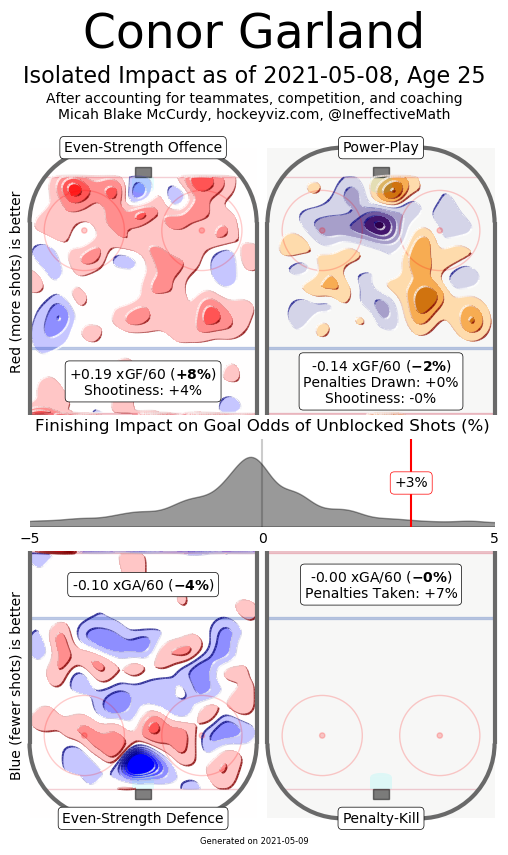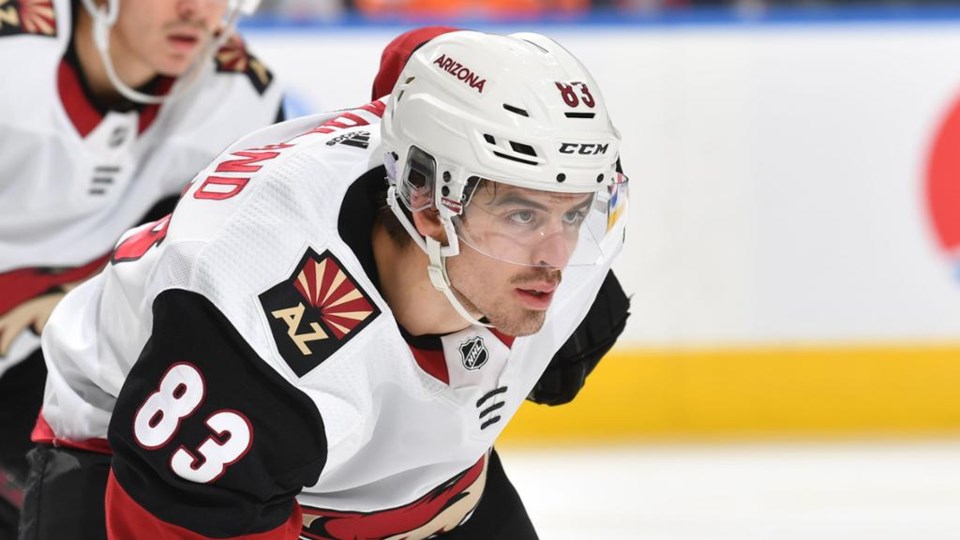So far this offseason, Vancouver Canucks GM Jim Benning has been focused on aggressively overhauling his defence. His most important acquisition, however, was arguably at forward.
While the Canucks’ defence certainly looks different, it’s fair to wonder if their blue line is actually any better than it was last season. Their forward group, however, has definitely been improved.
It started before the Seattle Kraken expansion draft when Benning traded a third-round pick for Jason Dickinson, a defensively responsible centre who should provide a boost to the team’s third line. That pushes the re-signed Brandon Sutter to the fourth line, where he can play a smaller role that is better suited to his skillset.
The Canucks’ biggest acquisition is, ironically, also their smallest: Conor Garland.
Garland was part of the Canucks’ pre-draft trade with the Arizona Coyotes alongside defenceman Oliver Ekman-Larsson. Though Garland is certainly the lesser-known name compared to Ekman-Larsson, he’s the key piece of the trade — a legitimate top-six, playmaking winger, who should immediately make the Canucks a more dangerous team offensively.
What makes Garland so effective? I took a look at the analytics and went shift-by-shift through one of his recent games to find the answer.
Judge me by my size, do you?
When I say that Garland is the team’s smallest acquisition, I mean it literally. He’s smaller even than Nic Petan, the 5’9” forward the Canucks signed as depth to play for the Abbotsford Canucks.
While he’s listed at 5’10” by the NHL, Garland himself will quickly tell you that’s not accurate, generally describing himself in interviews as 5’8”. He has proven that size isn’t everything, leading the Coyotes in points per game last season with 12 goals and 39 points in 49 games.
That lack of size meant a slightly longer road to the NHL. Garland went undrafted in his first year of eligibility despite 54 points in 51 QMJHL games — fifth among first-time draft-eligible players in the QMJHL. He led the league in scoring the following season with 129 points in 67 games, 27 more points than the next best player, and still didn’t get picked until the fifth round.
Garland didn’t make it to the NHL until he made it impossible for the Coyotes to keep him in the AHL. He had 19 points in 18 AHL games the season when he was finally called up to the NHL at 22. Combined with a couple of COVID-shortened seasons, Garland has only played 164 NHL games in his three seasons but has quickly established himself as a top-six threat.
Like some other smaller players, Garland has found success by playing a scrappy, fearless game.
“To be a small guy in the league, you have to be on the interior,” said Garland after the trade. “It’s hard to make it as a perimeter player when you’re 5’7”-5’8” like myself. I grew up watching [Brad] Marchand and [Brendan] Gallagher and guys like that, so I learned a lot from them. You can’t be scared out there. I’m not really scared of too much out there. You’re going to get hit once in a while and just take it and keep moving.”
You can see that scrappy effort along the boards in the clip below. Garland, wearing #83, protects the puck and makes a couple of nice passes to Jan Jenik, wearing #73. When he fans on a centring pass and gets taken into the boards, Garland still manages to pass the puck to Victor Soderstrom at the point to keep the possession alive.
After a quick pass back-and-forth between Soderstrom and Oliver Ekman-Larsson, Soderstrom steps around his man and snipes his first career NHL goal, with Garland getting the second assist.
Possessing the puck like Pazuzu
That work along the boards is a key part of Garland’s possession game and one of the biggest ways he can help the Canucks.
It’s clear from various forms of analytics that Garland pushes puck possession in the right direction. He had a 51.67% corsi, which means the Coyotes regularly had more shot attempts than their opposition when Garland was on the ice at 5-on-5.
As a more visual illustration of that impact, we can use the isolated impact heatmaps from HockeyViz. These take into account context such as quality of competition, teammates, and usage.
 Conor Garland's isolated impact heatmap via HockeyViz.com
Conor Garland's isolated impact heatmap via HockeyViz.comGarland has a significant impact on offence, with the Coyotes’ shots 9% more dangerous when he’s on the ice at 5-on-5. Likewise, he has a strong impact on defence, making opponents’ shots 4% less dangerous.
A lot of that comes from winning battles and controlling the puck along the boards and Benning is hoping that it’s contagious.
“He’s a kid that competes hard on the puck, a relentless worker, has good skill, and his work ethic is gonna rub off on all of our other guys,” said Benning.
Conor Garland is...The Transporter
Another key element of Garland’s possession game is his ability to transport the puck up ice. He's like Frank Martin, transporting anything, no questions asked. He is excellent in transition, particularly when it comes to gaining the offensive zone with control of the puck. He uses his intelligence, shifty skating, soft hands, and excellent vision to get the puck from zone to zone effectively.
Garland was even used as the puck carrier on the power play, trusted with picking up the drop pass and gaining the zone, but he was equally effective at 5-on-5.
The clip below is an end-to-end example. He picks up the puck from his goaltender, loops behind the net, then neatly evades the forechecker with a clever bank pass to his defenceman. He then picks up speed and gets open down the left wing for the return pass, easily gains the zone, and flips a short pass to Jenik, who can’t quite connect on the bouncing puck.
Here’s another example of Garland smartly controlling possession on a zone entry as he moves down the right wing 1-on-3. Instead of just throwing the puck in deep and starting a forechecking sequence, he fakes a shot then curls back, allowing his teammates to catch up and join the play.
After skating around the outside with the puck and sliding a pass in below the goal line, Garland then slyly gets open at the backdoor, where Ekman-Larsson finds him with a Sedin-esque slap pass. Garland’s redirect is a good one but he gets robbed by the goaltender.
There were several examples of Garland making a simple play to exit the defensive zone — a one-touch pass to a hard-skating teammate or being in the right place at the right time to skate the puck out himself — but he’s also capable of using his shifty skating and skill to evade pressure.
In the clip below, Garland deceives a forechecker into thinking he’ll pass the puck back to his defenceman, then spins off the check and uses another bank pass into the neutral zone.
While his teammate loses the puck, Garland keeps up the pressure and finishes his check, forcing an icing call on the Sharks. That leads directly to the next key component of Garland’s game: his pressure on the puck.
We’ll head them off at the pass
Garland’s best defensive work wasn’t in the defensive zone. Instead, it came from making heads-up plays on the forecheck and in the neutral zone. He’s very savvy at reading the play and picking the right moment to jump in and disrupt the puck carrier or pick off a pass.
Take the play below, where Garland is at the bottom of the screen, lurking. He sees where the puck carrier is going to come out from behind the net and pounces, getting his stick on the puck to create a turnover, eventually leading to a shot on goal.
Here’s another example of Garland reading the breakout and getting to the right place to break it up. He comes from the top of the screen, all the way across the ice when he sees where the pass will go and cuts it off. While the Sharks regain possession, it’s still a heads-up play.
He also repeatedly made smart plays in the neutral zone in the shifts I watched. Sometimes it was as simple as putting pressure on the puck carrier at the right time to guide them into a teammate for a turnover or forcing a dump-in instead of a controlled zone entry. Sometimes he picked off the puck entirely and quickly turned it back into an opportunity for offence.
That’s what he did in the below clip, picking off a stretch pass at centre ice, and turning to the attack, slipping a pass under the triangle of a Shark stick for a quick 2-on-1 and a Coyotes scoring chance.
That segues nicely to Garland’s offensive game, where he’s primarily a playmaker.
Making passes and making plays
Whoever gets to play with Garland will be extremely happy. He’s an adept passer, putting the puck on the blades of his linemates in stride and creating chances.
“He’s going to have lots of opportunity. He’s going to play with good players,” said Benning. “I don’t know if he’ll play on the first line or the second line, but he’s a guy that makes other players around him better.”
Heading into last season, Garland saw his assist totals as an area where he wanted to improve . He succeeded, leading the Coyotes in assists. If he gets to play with finishers like Elias Pettersson, Brock Boeser, and Bo Horvat, perhaps he can improve those assist totals even more.
“I just like to play a hard game, trying to get the puck below the goal line to make plays,” said Garland. “I kind of view myself as a pass-first kind of guy, but I’m gonna score my goals in tight after rebounds, deflections, stuff like that. I just want to be an easy guy to play with.”
Garland’s preference for working below the goal line is immediately evident from watching him play. He likes to get the puck down low to create chances, such as in the clip below, when he takes a pass behind the net and backhands a pass against the grain to Michael Bunting for a scoring chance.
Garland is also a smart playmaker, as in the assist below, where he recognizes that Evander Kane has broken his stick and stops up, creating an easy passing lane across to Bunting for the finish.
It’s a nice take on the backhand as well as he exits the zone. This was a trend: Garland is adept at picking up pucks on both the forehand and backhand. He neatly took a hard ring-a-round the boards on the backhand and controlled it immediately. This is an underrated skill.
Overall, Garland’s passing is a noticeable plus, whether a simple one-touch pass to get out of the zone or spotting a teammate through multiple layers of traffic.
Shots, shots, shots, shots, shots, shots
While Garland is primarily a playmaker and emphasized that his goalscoring comes from in front of the net, he has a decent shot as well. He scored 12 goals in 49 games last season — a 20-goal pace over 82 games — and definitely scored some of those goals on rebounds, tips, and deflections, but also had a few go in cleanly off nice shots.
One of those nice shots was a 5-on-3 goal in the shifts I watched.
Garland lined up in the bumper spot at 5-on-4 on the power play, where he could use his smart positioning and deft passing to keep the puck moving. When the one-man advantage became a two-man advantage, however, he moved to the point alongside Jacob Chychrun. Earlier in the power play, he set up Chychrun for a one-timer, then Chychrun returned the favour.
It’s a wonderful shot by Garland, hard and low through the five-hole.
What might be surprising for someone who describes himself as a “pass-first player,” he actually takes a lot of shots. He led the Coyotes in shots on goal per 60 minutes at 5-on-5 last season and his 135 total shots would have been second on the Canucks behind Brock Boeser.
A lot of his shots seem designed to create rebounds or opportunities for tips rather than for scoring goals but he’s got a decent enough shot that it seems he could be shooting to score more often.
Defensively safe and sound
Defensively, I was left whelmed by Garland — neither over nor under, just whelmed.
The word that comes to mind is “safe.” Garland’s off-puck positioning was solid and he kept his head on a swivel, constantly checking to make sure his man didn’t sneak in off the point. Often, when it comes to a winger, that’s all you really want or expect.
I decided to save you the boredom of watching clips of Garland staying in position at the point. Hopefully you can simply trust that he did so.
Given Garland’s ability to read the play and pick off pucks in the offensive zone and neutral zone, however, he seemed oddly passive in the defensive zone. It seemed like he could have done a bit more when plays broke down to support or cover his teammates defensively.
Still, there’s nothing really to complain about and his defensive numbers are decent enough. It just seems clear that his best defensive work happens outside the defensive zone. With his work on the forecheck and in the neutral zone, he already has an impact defensively — it just seems like he could do a little bit more.
Of course, another underrated element of his defensive game is just getting the puck out of the zone when he has the chance. Simply avoiding getting hemmed in the defensive zone for extended shifts helps limit shots and chances against.
According to Garland, improving his defensive game was a focus for himself and his coach last season.
“Rick Tocchet this year worked a lot on that, helping me become more defensively reliable, so I can be a first-line player in the league,” said Garland. “You can’t [play on a first line] if you can’t play on the other side of the puck.”
That’s good because it’s guaranteed that his new head coach, Travis Green, will have the same expectations of Garland defensively.
Overall conclusions
So, who is Conor Garland and what should Canucks fans expect from him next season?
From the analytics and watching him play, Garland is an intelligent, scrappy playmaker, whose strongest skill is reading the play. His hockey sense is superb, allowing him to repeatedly find soft spots in defensive coverage to get open for shots or read the defence to manipulate them to open up passing lanes.
He also uses that ability to read opposing players to forecheck effectively. He’s not going to run anyone over, but he smartly puts himself in a position to force turnovers or prevent clean breakouts.
Fans will love his work rate, as he’s constantly driving to get the puck in the offensive and neutral zones and looking to create offence out of turnovers. In almost every single shift, he's making something positive happen on the ice.
Most importantly, he combines his hockey sense with his shifty skating, excellent hands, and vision to maintain possession of the puck in the offensive zone. That’s something that has often been a weakness for the Canucks over the past few seasons — Garland will help in that area.
All of those abilities should allow him to set a new career high in points with the Canucks. He should be capable of around 25 goals and 60 points. The one element that may limit his scoring is that he might not be on the first unit on the power play, where 10 of his 39 points came from last season.
Would the Canucks take Bo Horvat off the first unit for Garland? What about Brock Boeser?
It seems more likely that Garland would land on the second unit with Nils Höglander, Tanner Pearson, Vasily Podkolzin, and Oliver Ekman-Larsson. That has the potential to be a very good power play unit, but they’ll certainly get less ice time than the first unit.
At 5-on-5, however, Garland should significantly boost the Canucks’ top-six, whether on the first or second line.





